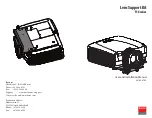
12
6.1.1
Date and Time
The date/time defaults to January 1, 2000. This is non-persistent and should be set after powering up
the Sasquatch. The Date/Time Set flag can be queried to see if this has been done. The logs will use this
information to timestamp each log entry. If the date/time is changed, all new log entries will use the
new date/time. Old entries will not be updated and will remain in the order in which they were
recorded.
6.1.2
Units
The units of the Sasquatch can be set to either Metric or Imperial. This setting will affect the internal
calculations and the velocity will be logged in the given units.
6.2
Arrival Log
The Arrival Log is a historical log that stores the last 120 arrivals in reverse chronological order. This
means that the most recent log entry will always appear at the top of the log. The following
information is stored in the Arrival Log.
6.2.1
Arrival Time
This is the date/time of the arrival. It is accessible as a collection of registers that each represents part
of the date and time or two registers that represents the total number of seconds since January 1, 2000.
6.2.2
Velocity
The velocity value is the calculated velocity of the given arrival. It is either reported as m/min or
feet/min, depending on the configured units.
6.2.3
Velocity Confidence Code
The velocity code indicates whether the calculated velocity is valid, or if an error occurred during the
calculation. If the velocity is valid, this code also provides a figure of merit in the confidence of the
velocity.
7
Lubricator / Spring Wear Monitoring
An important reason for knowing plunger speed at surface is to know if the lubricator is being damaged
by hard plunger hits. The Sasquatch can monitor plunger arrivals to determine if the well is operating
safely and if the lubricator spring may need maintenance or replacement. The ability for a lubricator to
absorb a plunger hit is specified in kinetic energy units
–
inch-pounds (in-lbs) in imperial or Joules (J) in
metric. The Sasquatch can convert plunger speed into kinetic energy and activate an alarm to indicate
that the lubricator is under stress.
The API standard for plunger lift well heads specifies that manufactures should stamp a kinetic energy
rating on the equipment they produce. The standard lists kinetic energy and plunger mass in these
imperial units: in-lbs and lbs, so for convenience, the Sasquatch uses the same units. Likewise, for the
metric units of kg and J.
Two key pieces of information are required to configure the Sasquatch for this functionality:
















































